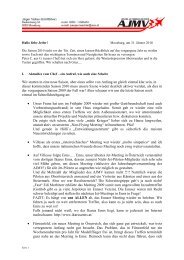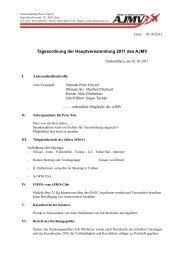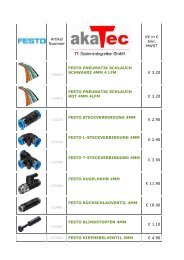A turbofan Viper is coming to replace the rowdy, thirsty ... - AKATEC IT
A turbofan Viper is coming to replace the rowdy, thirsty ... - AKATEC IT
A turbofan Viper is coming to replace the rowdy, thirsty ... - AKATEC IT
Create successful ePaper yourself
Turn your PDF publications into a flip-book with our unique Google optimized e-Paper software.
<strong>Viper</strong>Jet continued<br />
Th e bro<strong>the</strong>rs were involved in buying<br />
and selling French Fouga Mag<strong>is</strong>ters. Th ey<br />
called an associate, and two weeks later a<br />
Turbo Mecca jet, <strong>the</strong> same engine that<br />
powers <strong>the</strong> French jet trainer, arrived.<br />
Th irty days later <strong>the</strong>y were taxiing.<br />
Th e fi rst fl ight was in 1999. Th ey fl ew<br />
for a year and <strong>the</strong>n switched <strong>to</strong> a T-58<br />
turboshaft from a CH-46 helicopter.<br />
Th e drive portion of <strong>the</strong> engine was<br />
<strong>replace</strong>d by a tailpipe, converting <strong>the</strong><br />
shaft engine in<strong>to</strong> a jet with 700 pounds<br />
of thrust. Th at engine was underpowered,<br />
and when <strong>the</strong> military gave <strong>the</strong><br />
fi refi ghters fi rst chance at <strong>the</strong> surplus<br />
engines, <strong>the</strong> supply dried up and ano<strong>the</strong>r<br />
engine choice was needed.<br />
Fortui<strong>to</strong>usly, a Lear 23 landed at Pasco<br />
one day. Th e bro<strong>the</strong>rs measured <strong>the</strong><br />
engine and realized it would fi t, and it<br />
would provide more than enough thrust.<br />
At that point <strong>the</strong>y had sold fi ve kits. “We<br />
upgraded those kits <strong>to</strong> <strong>the</strong> MKII confi guration<br />
(with a carbon-fi ber wing) at no<br />
charge,” Scott said. Th e fi rst fl ight of <strong>the</strong><br />
MKII was on June 12, 2005.<br />
Winging It<br />
Th e MKII airplane has 25° of wing<br />
sweep in <strong>the</strong> leading edge and 6° in <strong>the</strong><br />
trailing edge, but <strong>the</strong> airplane handles<br />
and fl ies like a straight-wing airplane.<br />
All of <strong>the</strong> controls are actuated by pushrods<br />
except <strong>the</strong> rudder, which has cables.<br />
Th e nosewheel casters, and <strong>the</strong> gear, fl aps<br />
and speed brakes are electro/hydraulic.<br />
Clever features are incorporated<br />
throughout. Some of <strong>the</strong> most ingenious<br />
are <strong>the</strong> electromagnetic landing-gear-up<br />
locks. Th e down-locks are integral in <strong>the</strong><br />
actua<strong>to</strong>rs, using a ball/collar system that<br />
snaps down by ei<strong>the</strong>r hydraulic pressure,<br />
carbon dioxide blow-down or gravity,<br />
and are released by <strong>the</strong> hydraulic pressure<br />
on retraction.<br />
Th e cockpit looks more like a luxury<br />
car than a hot-rod jet—a big change from<br />
<strong>the</strong> previous iteration of th<strong>is</strong> aircraft .<br />
Th e canopy <strong>is</strong> rear hinged and opens<br />
manually on a gas strut, pulled down by<br />
a convenient and simple hanging strap.<br />
Th e canopy hinge seems strong enough<br />
<strong>to</strong> handle <strong>the</strong> strongest winds; locks are<br />
robust and designed <strong>to</strong> hold <strong>the</strong> 5.5 psi<br />
cabin diff erential that will be in subsequent<br />
airplanes. Th e limited amount of<br />
panel space in <strong>the</strong> front cockpit <strong>is</strong> used<br />
effi ciently by a pair of Op Technologies<br />
integrated EFIS screens that include<br />
navigation, com and engine instrumentation.<br />
Th e rear cockpit has a third EFIS<br />
panel integrated with <strong>the</strong> front cockpit.<br />
Th e airplane always had a tail stand<br />
in place, and <strong>the</strong> crew at <strong>Viper</strong>Jet were<br />
careful <strong>to</strong> tend <strong>the</strong> nose when it did not.<br />
Without <strong>the</strong> tail stand, and with no passengers<br />
in <strong>the</strong> airplane, <strong>the</strong> weight on <strong>the</strong><br />
nosewheel was minimal. A step slides in<strong>to</strong><br />
a receptacle on <strong>the</strong> left side for boarding,<br />
and <strong>the</strong> front cockpit <strong>is</strong> comfortable. I<br />
was relegated <strong>to</strong> <strong>the</strong> rear seat, which was<br />
also comfortable, with good head and<br />
legroom, but <strong>the</strong> canopy longerons were<br />
tight just above my elbows.<br />
Th e battery <strong>is</strong> adequate for starting<br />
<strong>the</strong> turbo-jet, but <strong>the</strong> J85 and <strong>the</strong> CJ-610<br />
are single-shaft engines, and <strong>the</strong> starter<br />
must spin <strong>the</strong> entire rotating element;<br />
using ground power ensures cooler starts<br />
and lower engine maintenance costs.<br />
Starting <strong>is</strong> simple: Turn on <strong>the</strong> boost<br />
pump, <strong>the</strong> igniter and <strong>the</strong> starter. When<br />
<strong>the</strong> engine reaches 10% rpm, turn on <strong>the</strong><br />
fuel and moni<strong>to</strong>r <strong>the</strong> Internal Turbine<br />
Temp (<strong>IT</strong>T) for a hot start. When <strong>the</strong><br />
engine <strong>is</strong> idling, <strong>the</strong> starter becomes <strong>the</strong><br />
genera<strong>to</strong>r, <strong>the</strong> ignition <strong>is</strong> turned off , and<br />
<strong>the</strong> fi re <strong>is</strong> self sustaining.<br />
Gulp...<br />
Even at idle power <strong>the</strong> J85 burns 75 gallons<br />
per hour. Th at <strong>is</strong> not a m<strong>is</strong>print. Th e<br />
airplane holds only 300 gallons in three<br />
tanks, so once <strong>the</strong> engine <strong>is</strong> running,<br />
getting airborne becomes a priority.<br />
Little additional thrust <strong>is</strong> needed for<br />
taxi, and once <strong>the</strong> airplane <strong>is</strong> moving it<br />
rolls easily. Th e rudder seems eff ective at<br />
low speeds, and little braking <strong>is</strong> needed<br />
<strong>to</strong> steer. Th ere <strong>is</strong> no need <strong>to</strong> run up a jet,<br />
and <strong>the</strong> before takeoff checkl<strong>is</strong>t <strong>is</strong> short.<br />
Cleared for takeoff , we <strong>to</strong>ok <strong>the</strong> runway<br />
and <strong>the</strong> fun was about <strong>to</strong> begin. I<br />
was a passenger for <strong>the</strong> takeoff , but it<br />
was straightforward and fast. To say<br />
<strong>the</strong> acceleration was br<strong>is</strong>k <strong>is</strong> an understatement.<br />
A boot in <strong>the</strong> butt <strong>is</strong> a better<br />
assessment. Th e airplane sits nose<br />
low, and it appeared <strong>to</strong> require a tug <strong>to</strong><br />
unstick <strong>the</strong> nose at around 90 knots. By<br />
<strong>the</strong> time <strong>the</strong> nose was up, we were air-<br />
10 K<strong>IT</strong>PLANES March 2009 www.kitplanes.com





